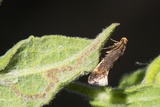Apodia bifractella (Duponchel, 1843) Species
Last modified: Feb. 26, 2024, 5:58 p.m.
A not so common species in Belgium. Adults are very secretive and probably underrecorded, but it's believed that it may be fairly common wherever the food plants occur. More observations in the north of the country.
Details
- Classification
- Family: Gelechiidae > Subfamily: Anomologinae > Genus: Apodia > Species: Apodia bifractella
- Vernacular names
- Heelblaadjespalpmot (NL), Dark Fleabane Neb, Dark Seedhead Moth (EN), Flohkraut-Palpenmotte (DE)
- First mention in Belgium
- Fologne E. 1862b. Observations sur quelques Lépidoptères observés en Belgique. — Annales de la Société entomologique belge 6: 161–169. On page 167.
- Status
-
Native
Distribution
Bionomics
The larva feeds on the seeds of the food plant and it hibernates in a narrow tube which is made by spinning the seeds together. There are no external feeding signs. Pupates in a tough silken cocoon mixed with frass and seed fragments.
The adults become active from late afternoon and later come to light.
Flight periods
The adults fly in one generation a year from mid-July till late September.
Observed on
- Host plant (species):
- Pulicaria dysenterica and Inula conyza
The larva feeds on the seeds of Pulicaria dysenterica and Inula conyzae. Also reported from Aster tripolium.
Habitat
It inhabits in suitable localities where the food plant occurs and is found in a wide range of habitats.

